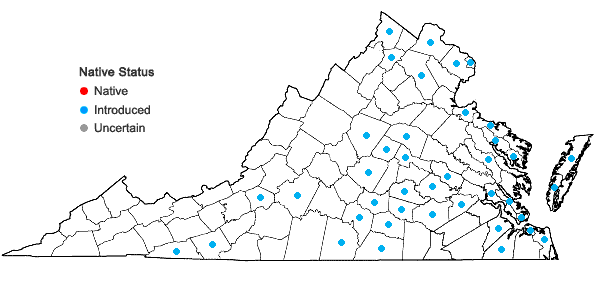Rubus bifrons Vest

Detail
- Family
- Rosaceae
- Botanical Name
- Rubus bifrons Vest
- Common Name
- European Blackberry, Himalayan Blackberry
- Synonym(s)
- Rubus discolor Weihe & Nees; Rubus pascuus L.H. Bailey, misapplied?; Rubus procerus P.J. Muller ex Boulay; Rubus armeniacus Focke
- Flora of Virginia Name/Status
- Rubus bifrons Vest. + Rubus pascuus L.H. Bailey
- Comments
- This large, heavily armed species can be highly invasive, and appears to be rapidly increasing in the Coastal Plain and Piedmont.
We follow Alice et al. (2014) in FNA9 in lumping the alien blackberries traditionally mapped here as Rubus bifrons and Rubus discolor. For reasons that are not clear, Flora of the Southeastern U.S. more recently synonymized Rubus discolor with Rubus pascuus L.H. Bailey, an obscure species that Bailey, H.A. Davis, and FNA all treat as a native taxon. FNA cautions, however, that use of the name “Rubus pascuus” is tentative, and opine that the taxon “may represent a stabilized hybrid between a European and a native blackberry species...”
Simmons and Fleming have examined herbarium specimens of this complex at US, AVCH, GMUF, WILLI, LYN, and FARM, as well as numerous living populations in Virginia. These observations revealed a high degree of morphological variation within and across populations that totally obscured the significance of characters that supposedly differentiate R. bifrons from the discolor/pascuus entity. In short, characters such as prickle shape, stem pubscence, and flower color are highly variable, even in the same population, and simply don't hold up to distinguish two taxa. The FNA authors came to a similar conclusion and felt that “until a much-needed genetic study is performed that includes a broad selection of plants of ser. Discolores from throughout North America, Europe, and elsewhere, the precise identities of all of our material in this complex will be elusive.” Given the uncertainties, FNA adopted a broad interpretation of the name Rubus bifrons for the complex.
- Habitat
- Old fields, fencerows, clearings, and roadsides. Infrequent but often locally abundant where found; primarily Piedmont and Coastal Plain.
- Native Status
- Introduced
To save this map, right-click (control-click for Mac users) on the map and choose "Save Image As...".





